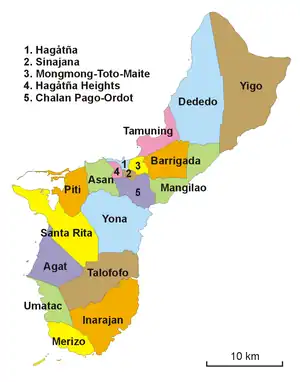Villages of Guam
The United States territory of Guam is divided into nineteen municipalities, called villages.[1] Each village is governed by an elected mayor. Village populations range in size from under 1,000 to over 40,000. In the 2020 census, the total population of Guam was 153,836.[2] Each municipality,[3] known as an "election district" by the United States Census Bureau, is counted as a county equivalent by the Census Bureau for statistical purposes.[4]
| Villages of Guam Songsong Guåhan (Chamorro) | |
|---|---|
 | |
| Category | County equivalent |
| Location | Guam |
| Number | 19 |
| Populations | 647 (Umatac) – 44,908 (Dededo) |
| Areas | 0.89 sq mi (2.3 km2) (Sinajana) – 35.61 sq mi (92.2 km2) (Yigo) |
| Government | |
 |
|---|
History
Many villages have rich histories reaching back thousands of years. Artifacts from ancient Chamorro settlements can be found in every village of Guam. When the Spanish Empire colonized the Marianas Islands as part of its Pacific possessions in the 16th and 17th centuries, the island was divided into separate districts with each district consisting of a parish with a village center governed by a Mayor alcalde, appointed by the island's governor.
In the 18th century, there were six parishes on Guam: Hagåtña, Hagat, Humåtak, Malesso', Inalåjan, and Pago.
Prior to Spanish colonization, Chamorro people regularly held village celebrations. After adopting Christianity, these celebrations became festivals (fiestas) in honor of the patron saint of each village. Annual village fiestas are still held throughout the island every year.
The current division of Guam into municipalities took place in the 1920s under United States Navy Administration. Santa Rita was formerly Sumay, before the U.S. taking of that village after World War II.
List of villages
| Village | Region[5] | Land area[3] | Population[2] | Population density (2020) | |||
|---|---|---|---|---|---|---|---|
| sq mi | km2 | 2020 | 2010 | per sq mi | per km2 | ||
| Agana Heights | Central | 1.03 | 2.67 | 3,673 | 3,808 | 3,566 | 1,377 |
| Asan-Maina | Central | 5.69 | 14.74 | 2,011 | 2,137 | 353 | 136 |
| Barrigada | Central | 8.50 | 22.01 | 7,956 | 8,875 | 936 | 361 |
| Chalan Pago-Ordot | Central | 5.67 | 14.69 | 7,064 | 6,822 | 1,246 | 481 |
| Dededo | North | 30.52 | 79.05 | 44,908 | 44,943 | 1,471 | 568 |
| Hågat (formerly Agat) | South | 10.33 | 26.75 | 4,515 | 4,917 | 437 | 169 |
| Hagåtña | Central | 0.95 | 2.46 | 943 | 1,051 | 993 | 383 |
| Humåtak (formerly Umatac) | South | 6.25 | 16.19 | 647 | 782 | 104 | 40 |
| Inalåhan (formerly Inarajan) | South | 18.74 | 48.54 | 2,317 | 2,273 | 124 | 48 |
| Malesso' (formerly Merizo) | South | 6.26 | 16.21 | 1,604 | 1,850 | 256 | 99 |
| Mangilao | Central | 10.19 | 26.39 | 13,476 | 15,191 | 1,322 | 511 |
| Mongmong-Toto-Maite | Central | 1.82 | 4.71 | 6,380 | 6,825 | 3,505 | 1,353 |
| Piti | Central | 7.54 | 19.53 | 1,585 | 1,454 | 210 | 81 |
| Sånta Rita-Sumai (formerly Santa Rita) | South | 16.26 | 42.11 | 6,470 | 6,084 | 398 | 154 |
| Sinajana | Central | 0.89 | 2.31 | 2,611 | 2,592 | 2,934 | 1,133 |
| Talo'fo'fo (formerly Talofofo) | South | 17.79 | 46.08 | 3,550 | 3,050 | 200 | 77 |
| Tamuning | North | 5.65 | 14.63 | 18,489 | 19,685 | 3,272 | 1,263 |
| Yigo | North | 35.61 | 92.23 | 19,339 | 20,539 | 543 | 210 |
| Yona | South | 20.12 | 52.11 | 6,298 | 6,480 | 313 | 121 |
| Guam | 209.81 | 543.41 | 153,836 | 159,358 | 733 | 283 | |
See also
References
- "Village Maps". Pacific Daily News. Archived from the original on 2012-12-08. Retrieved 2023-07-02 – via Archive.today. (Archive at Ghostarchive)
- Population of Guam: 2010 and 2020, U.S. Census Bureau.
- Population, Housing Units, Land Area, and Density by Municipality for Guam: 2010, U.S. Census Bureau.
- "Geographic Levels". United States Census Bureau. Suitland, Maryland. September 12, 2016. Archived from the original on 2020-12-31. Retrieved 31 December 2020.
- "iaea2006report". U.S. Department of the Interior. Archived from the original on 2007-10-31. Retrieved 2007-12-31.
- Rogers, Robert F (1995). Destiny's Landfall: A History of Guam: University of Hawai'i Press. ISBN 0-8248-1678-1
- Carter, Lee D; Carter, Rosa Roberto; Wuerch, William L (1997). Guam History: Perspectives Volume One: MARC. ISBN 1-878453-28-9
- Sanchez, Pedro C. Guahan, Guam: The History of our Island: Sanchez Publishing House.
- "Guam-Election Districts" (PDF). U.S. Census Bureau. Retrieved 2023-07-02.
External links
- "Municipalities of Guam". Statoids.
- "Guam Villages". Guampedia. September 15, 2020. Retrieved March 19, 2021.
- "1990 COUNTY BLOCK MAP (RECREATED): GUAM" (PDF). U.S. Census Bureau.